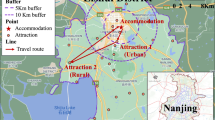Abstract
The shift of travel demand policies from the conventional supply oriented policies to management oriented policies has made the effectiveness of conventional models questionable. However, although the new generation travel demand models have theoretically appealing backgrounds, they have so far failed to fully attract the practitioners to apply them for practical purposes. Lack at proper understanding and wrong perceptions of the new generation models have contributed to the gap between research and practice. This paper suggests a way to incorporate the features of new generation models using ordinary PT (person trip) data, to get an optimum model. Based on this, we propose a model that captures the link among travel decisions of a day as a travel pattern. We also illustrate the practical advantages of the new generation models, comparing with conventional models, in evaluating policies by an empirical study.
Similar content being viewed by others
References
Algers, S., Daly, A., Kjellman, P., and Widlert, S. (1995). “Stockholm model system (SIMS): Application.” Proceedings of Seventh World Conference of Transportation Research, Sydney.
Ben-Akivai, M. E., Bowman, John L., and Gopinath, D. (1996). “Travel demand model system for the information era.” Transportation, Vol. 23, pp. 241–266.
Ben-Akivai, M. E. and Lerman, S. R. (1985). Discrete choice analysis: theory and application to travel demand, Cambridge, MA: MIT Press.
Cascetta, E., Nuzzolo, A., and Velardi, V. (1993). A system of mathematical models for the evaluation of integrated traffic planning and control policies, Unpublished Report, Laboratorio Richerche Gestione e Controllo Traffico, Salerno, Italy.
Cascetta, E. and Biggiero, L. (1997). “Integrated models for simulating the Italian passenger transport system.” Eighth Symposium on Transportation Systems, Chania, Greece, pp. 315–321.
Choo, S., Park, Y., and Lee, S. (2006). Developing travel demand models considering information and communications factors, Basic Research Report 2006-14, The Korea Transport Institute (in Korean).
Daly, A. J., van Zwam, H. H. P., and van der Valk, J. (1983). “Application of disaggregate models for a regional transport study in the netherlands.” World Conference on Transport Research, Hamburg.
Davidson, W., Donnelly, R., Freedman, P. V. J., Ruegg, S., Hicks, J., Castiglione, J., and Picado, R. (2006). “Synthesis of first practices and operational research approaches in activity-based travel demand modeling.” Transport. Res. Part A. doi:10.1016/j.tra.
Dijst, M. and Vidakovic, V. (1997). “Individual action-space in the city.” In: Activity-based Approaches to Travel Analysis, Ettema, D. F. and Timmermans, H. J. P., Pergamon, pp. 117–134.
Erik, E. S., Gregory, D. E., Thomas, F. R., and Jhon, C. (2006). “Processing the denver travel survey to support tour-based modeling,” TRB Conference.
Gunn, H. F., van der Hoorn, A. I. J. M., and Daly, A. J. (1987). “Long range country-wide travel demand forecasts from models for individual choice.” Fifth International Conference on Travel Behaviour, Aix-en Provence.
Hague Consulting Group (1992). The netherlands national model, 1990, The National Model System for Traffic and Transport, Ministry of Transport and Public Works, The Netherlands.
Nishii, K., Sasaki, K., Kitamura, R., and Kondo, K. (2005). “Recent developments in activity diary-based surveys and analysis: Some japanese case studies.” In: Timmermans, H. (Ed.), Progress in Activity-Based Analysis, Elsevier, Oxford, pp. 335–354.
Ohmori, N. (2008) “Application of information on human activitytravel behavior in urban space and time in the information age.” In: Sadahiro, Y. (Ed.) Spatial Data Infrastructure for Urban Regeneration, pp. 127–145, Springer, Japan.
Rossi, T. F. and Shiftan, Y. (1997). “Tour based travel demand modeling in the US.” Eighth Symposium on Transportation Systems, Ghania, Greece, pp. 409–414.
Ruiter, E. R. and Ben-Akiva, M. E. (1978). “Disaggregate travel demand models for the san francisco bay area.” Transportation Research Record No. 673, pp. 121–128.
Shiftan, Y. (1995). “A practical approach to incorporate trip chaining in urban travel models.” Fifth National Conference on Transportation Planning Methods and Applications, Seattle, Washington.
The MORPC Travel Demand Model (2005). Validation and final report, Prepared by PB Consult, Inc. for the Mid-Ohio Regional Planning Commission, Available by request from MORPC.
Vovsha, P., Bradley, M. A., and Bowman, J. L. (2004). “Activity-based travel forecasting models in the United States: Progress since 1995 and prospects for the future.” 2004 EIRASS Conference.
Author information
Authors and Affiliations
Corresponding author
Rights and permissions
About this article
Cite this article
Omer, M., Kim, H., Sasaki, K. et al. A tour-based travel demand model using person trip data and its application to advanced policies. KSCE J Civ Eng 14, 221–230 (2010). https://doi.org/10.1007/s12205-010-0221-6
Received:
Accepted:
Published:
Issue Date:
DOI: https://doi.org/10.1007/s12205-010-0221-6




